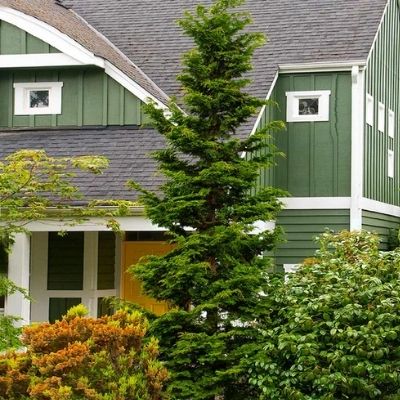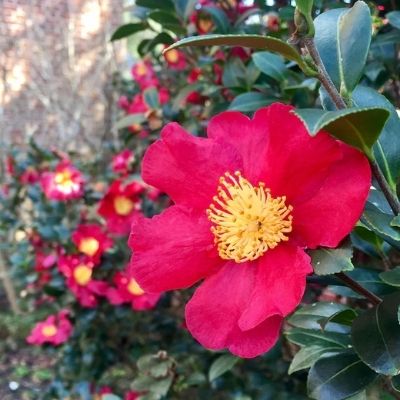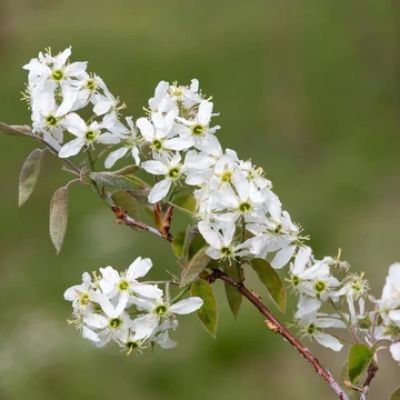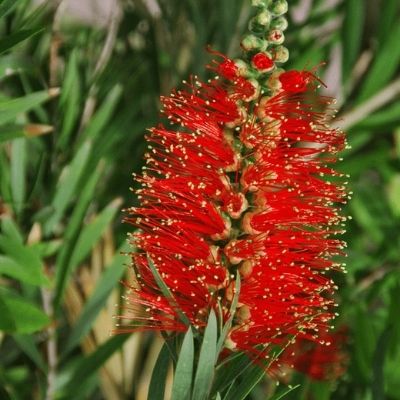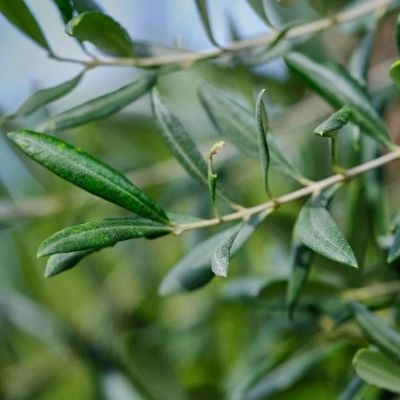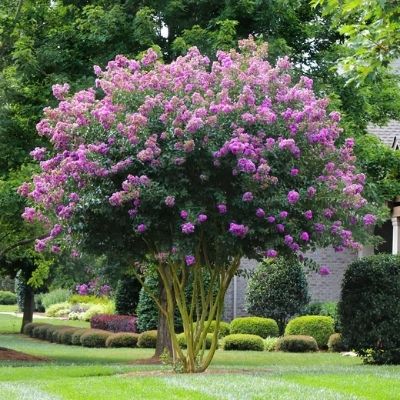Table of Contents
Trees For Small Gardens
If you are looking for the perfect tree to nestle right into your garden, you will be delighted to know that you have got plenty of options available to you. There are so many trees out there that can be planted into a small space and can fit into just about any yard - without being invasive to the setting of your outdoor area. What you should try to reflect on before you drive down to the nursery is exactly what kind of aesthetic you want your tree to add to your garden.
Trees come in all sorts of different shapes, sizes, and colors - with some that give off fruit and others that simply add ambiance. The key is to find one that is going to fit the scenery of your outdoor space by adding a complementary aesthetic to the natural surroundings of your yard. You can try to focus on color contrasting, color matching - or you can just use your gut feeling and simply get a tree that catches your eye.
Something else that you should consider is that a lot of trees have different types of seasonal patterns. If you want a small tree that is going to shed its leaves and give you all of those beautiful autumn colors and spring flowers, then you are going to want to go with a deciduous tree that will give your garden this variation. However, if you like the idea of a tree that retains the same look and feel are year-round, then an evergreen is going to be much more fitting for you.
Lastly, you should take a look at your yard and consider how much actual space you have for your small tree and where its position will be within your garden. While there are plenty of great small trees out there, you can expect even some of the smallest trees to get to be at least 10 ft high. A good way to approach this is to measure out your ideal spot and consider its surroundings - is it going to interfere with other plants in the garden once it reaches full size, will it block sunlight from reaching part of my yard or house, is it going to upset a neighbor? Once you have the measurements and logistics of your garden space, you should have no problem asking someone from your local nursery about the dimensions that you have to play around with. To help you find the best small tree for your garden, we are going to take a closer look at some of our top picks in more detail.
Ornamental Cherry Tree
Picture of the Ornamental Cherry Tree
If there is one thing that is even more lovely than the fruit that cherry trees produce it’s the flowers that bloom from them. This is one of the reasons that cherry trees are such a common sight in many gardens these days - regardless of whether the fruit is eaten or not.
While there are plenty of options of cherry trees out there that can get exceedingly large in size, there are some amazing ornamental cherry tree options that only get to be about 10 ft high, which makes this a great tree for a small garden. However, they can get a little bit wide when left unkempt. So, be sure to give them routine pruning when needed so that you can mitigate how wide they end up growing over the years.
For the most part, ornamental cherry trees will thrive in a variety of climates around the United States, but you will find that they grow better in areas that receive mild winters that have less humidity during the peak summer months.
The absolute best quality of ornamental cherry trees is the vibrant colors that they will bring to your garden. When in bloom, you will be dazzled by the gorgeous pink, lavender, and white-colored petals that give your garden an aesthetic that can only be described as enchanting.
If you want a cherry tree specifically for its fruit, then an ornamental option may not be the best for you. While these trees do produce cherries during the summer, you will find that they are quite inedible. Ornamental cherry trees produce fruit that is just too sour for most people to stomach, which is why the only ones that will benefit from the fruit are any critters that you have running around your yard. However, this is also a perk for your garden if you want to attract more wildlife.
Redbud Tree
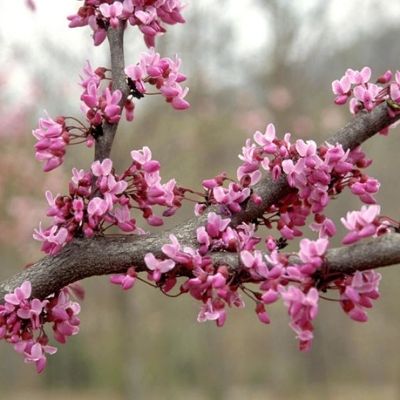
Picture of the Redbud Tree
If you are looking for a small tree to fit nicely into your garden without taking up too much space, then you really can’t go wrong with a redbud tree. These beautiful trees are elegant, give off a stunning violet color and, most importantly, they will be non-invasive to even some of the smallest gardens out there.
What we love about the redbud tree is that it can grow practically anywhere in the continental United States, which is why we see these small trees on each coast and even in the Heartland. You will find that the dwarf redbud tree practically never gets above 9 to 11 ft tall, but you can find some sorts that can be even smaller than that. You do want to make sure that you get a dwarf version of this tree, as the normal size redbud will get up to 25 to 30 ft, which is something that you are going to avoid in a small garden space.
Once planted, you can really enjoy the lovely contrast of a deciduous tree in your garden, as you watch the barren branches begin to bloom in the early parts of spring - to remind you that the warm weather is right around the corner. The redbud tree requires very little upkeep and you can take care of your annual pruning in a breeze thanks to the thin and easily accessible branches.
Magnolia Tree
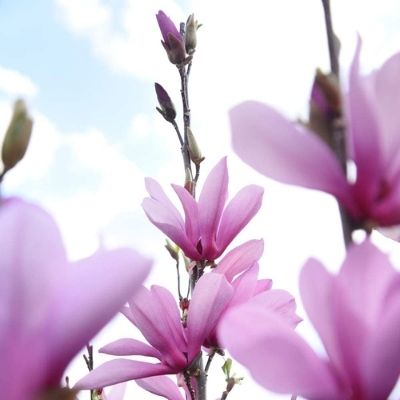
Picure of Magnolias
A magnolia tree is perfect for a gardener who enjoys the aesthetic of an evergreen but at the same time likes some leaves to fall on the ground during the colder months of the year. However, what you should keep in mind is that while magnolia trees are great for relatively small gardens, they do still get to be about 20 ft high. If you are working with a very small space, then you may want to consider a tree that is going to take up a bit less room.
With that being said, if you have space for this medium-sized tree, it will add a very nice character to your garden. Their large wax-like leaves look unique and their elegant violet and white flowers that blossom in the spring are beautiful, to say the least.
Once the magnolia tree’s gorgeous flowers begin to bloom, you (as well as most of your neighbors) will be able to enjoy the perfume-like scent that they give off. You should, however, be sure to plant this tree somewhere where it is not going to block shade from any other plants in your garden. So, try to find a nice area that is a bit isolated in your yard.
What is fascinating about the magnolia tree is that it is prehistoric, as it has been around for well over 100 million years. In fact, magnolia trees are so old, that they have been on Earth for longer than our primary pollinators - bees! So, if you want a tree in your garden that is literally ancient, a magnolia tree should do the job nicely.
Hinoki Cypress Tree
Picture of the Hinoki Cypress Tree
If you are on the fence between getting a shrub and a small tree, then the hinoki cypress is probably going to be the perfect medium for you. The hinoki cypress is a very shrubby-looking tree that originated from East Asia and Japan. Since then, it has become increasingly popular in the United States and is a common sight in so many gardens around the country.
There are a number of different variations of cypress trees out there that slightly vary in characteristics but can greatly vary in their size. You can find some variations that get to be as tall as 50 to 75 ft! However, there is a fantastic dwarf variation of the hinoki cypress tree that just gets to be a mere 6 to 10 ft, which makes it perfect for a small garden.
This is a great addition to a yard that you want to keep green, as the hinoki cypress is not deciduous and will retain its lush green color throughout the entire year. This is a great tree for complementing so many gardens and it can be used in a lot of different creative ways.
Given that the hinoki cypress primarily just grows straight up and does not get too wide, it can be a great tree to use as a barrier between your property and a neighbor’s. You can plant a handful of hinoki cypress trees alongside your fence so that they eventually grow tall enough to create a tree-like wall between you and a neighboring property.
Crab Apple Tree
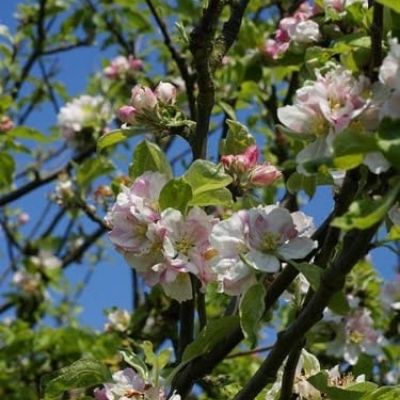
Picture of the Crab Apple Tree
A fantastic addition to just about any small garden is a crab apple tree. These trees are not as regarded for their fruit, which you can eat, but more for their gorgeous aesthetic.
This deciduous tree will give your garden a very lovely contrast throughout the year that reminds you of exactly what season it is. Once those barren branches get enough sunshine and warmth, they will begin to bud and flower - at which point, you will be delighted by the vibrant purple and white petals that light up your garden.
Crab apple trees are not known for getting too large but if you want to get the smallest option possible, you should buy one that is labeled as ‘compact’, as these are not known for getting much larger than 12 ft to 14 ft high.
While most people do buy crab apple trees to make their yard more pleasing to the eye, you can enjoy having some fresh fruit available at home when their seasonal apples come around. And if you are the type of gardener that loathes the idea of having to do too much pruning and yard work, the crab apple tree is relatively easy to take care of, as its branches are quite neat - just don’t let it get too overgrown.
Camellia
Picture of Camellias
Are you undecided about whether you want to plant flowers or trees in your small garden? Well, the Camellia may just be the tree that gives you the best of both worlds!
This small tree originated from Japan and gets to just a mere 6 to 12 ft tall, which makes it an ideal candidate for practically any small garden. What we love the most about the Camellia is how its flowers have a resemblance to roses. So, if you want to have a tree that can produce as many flowers as a dozen rose bushes, then the Camellia is going to be right up your alley.
In addition, the foliage of this tree stays green all year long, which means that you can enjoy its deciduous flowers during the right season and have lively green leaves throughout the rest of the year.
In some variations, this tree can grow to be significantly taller than 6 to 12 ft, but if you prune it properly and get a dwarf option, then you should have no issues fitting a Camellia neatly into your garden.
What we have found, however, is that this tree does grow quite wide. In some cases, it can be as tall as it is wide! This should not be an issue if you place it in an isolated place within your yard, but if you want to save as much space as possible, you can groom this tree down to be significantly less wide by pruning it when needed.
Camellias are actually a plant that falls in the middle between a tree and a shrub, which can be a win-win if you want to have both in your yard. You should be mindful of your climate, as Camellias do prefer climate zones that are a bit cooler.
Amelanchier
Picture of the Amelanchier
The Amelanchier is a gorgeous tree that produces white flowers that are perfect for contrasting other colors within your garden. This tree only gets to be about 10 ft tall in most cases but it can get to be as high as 16 ft, which may make it a bit too large for some people with very small gardens.
If you want to fit an Amelanchier into your petite garden, not all hope is lost. To make the most of your space, be sure to trim its branches to reduce how tall it gets, as this should do the trick for fitting it into most gardens.
When you go pick up your Amelanchier from your local nursery, you should keep in mind that this is a tree that goes by many names. Do not be surprised to see it labeled as shadwood, shadbush, wild plum, or juneberry.
If you love deciduous trees, then you should really put the Amelanchier at the top of your list, as the colors from this vibrant tree really evolve with each season. They will transition from an elegant white to vivid green, and end the flower season with a beautiful array of scarlet, orange, and red. So long as it is not winter, you will have some absolutely gorgeous flowers to gaze at in your garden.
To grow Amelanchier in the best possible climate, you should try to plant them in regions that get adequate sunlight but also plenty of moisture. They are particularly popular throughout parts of the Northwest, but you will find that they are perfectly capable of growing around various parts of the United States.
Bottlebrush Tree
Picture of a Bottlebrush Plan
If you have never seen a bottlebrush tree before, you will immediately recognize them the next time that you see one, as they are a standout. You can spot one easily by their very unusual yet strikingly beautiful flowers, which look like something that you would find growing on another planet.
The color of these flowers is a very bright and vibrant pink, which lights up a garden beautifully. In addition, they have green leaves that do not shed all year long, so that you have always got something that is lush and alive in your garden.
This is a perfect tree for a small garden, as they rarely get above 8 ft but can sometimes reach heights of 10 ft. What you want to do is make sure that you plant this tree somewhere in your garden that gets a substantial amount of sunlight and just small amounts of shade.
With that being said, the bottlebrush tree is not a plant that you will find growing in colder regions, which is why they were brought over here from Australia and they grow so well in states like Florida.
Olive Tree
Picture of the Olive Tree
When it comes to a small tree that will fit perfectly in pretty much any garden, the Olive Tree is by far one of the easiest options that you have available to you.
This is a tree that can grow to a height that is as little as just 5 to 7 ft. However, some sorts of olive trees can get to be well over 20 ft high, so make sure that you pick the right kind. If you want to mitigate how tall an olive tree gets, you should not have an issue doing so with proper pruning.
Olive trees do not give off a whole lot of color but sometimes that is exactly what you want in a tree. Their olive-like color is a perfect touch to add character to a small garden.
What is very interesting about olive trees is just how long they can live. On average, you can expect a typical olive tree to live as long as several hundred years - with the oldest one ever recorded being 2,000 years! So, if you plan on planting an olive tree in your garden, you can expect it to be there for generations to come.
However, if you live in a colder climate, you are probably going to want to reconsider planting an olive tree, as they tend to grow much better in Mediterranean-like climates that have got plenty of warmth.
Crape Myrtle
Picture of a Crape Myrtle Tree
If you want a lovely little tree that will add a quaint aesthetic to your garden, then the crape myrtle will fit in perfectly.
These beautiful trees are pleasing to the eye and are complemented by their vibrant pink and purple flowers that will darken and change as the season gets colder.
This is a great tree that can easily be mistaken for a shrub, which should have no problem fitting into even the smallest garden, as most of them will never get to be much taller than 8 or 10 ft. However, there are fantastic dwarf options of the crape myrtle that can grow to be just 5 ft. This makes the cape myrtle a very versatile tree for people with very small garden space.
What you will find is that the cape myrtle does not do too well in cold climates and thrives in warm ones, so try to plant this tree only if you live in an area that has mild winters and hot summers.
Recent Articles




